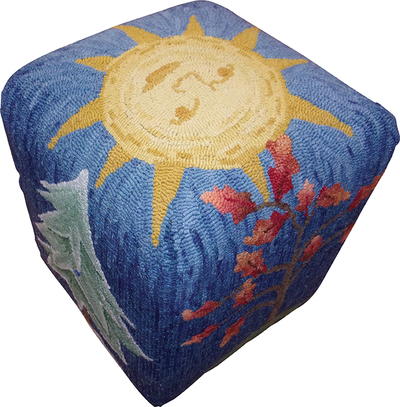Fancy Footstools
Every home needs a hooked hassock!

Seasons, 38 1⁄2" square. #8 1⁄2-cut wool. Designed by Kim Nixon and hooked by Margaret Bedle, Kerrville, Texas, 2017.
Pour yourself a cup of coffee, put up your feet, and read about a footstool project and how it came to be.
The rug hooking students in my mother, Karen Maddox’s, class were busy rug hooking when the conversation turned to the new line of Kim Nixon footstool patterns available from Honey Bee Hive. It didn’t take long until we had a group project planned and ready to execute.
Most of us used patterns from the Kim Nixon line; Karen Maddox designed stool patterns for herself and for Bess Wilson. Melissa Pattacini of Honey Bee Hive worked with us to get the correct size patterns to match the style of footstool each student chose. We chose the style of feet for our stools, and then the eight of us were ready to start the projects.
Our first step was to color plan. Thinking about where the stool would eventually be displayed was an important factor for each of us as we color planned. Margaret Bedle and Marlys Brooks both chose Kim Nixon’s Seasons pattern so we could watch how each of them developed into a unique piece.
Margaret used hand-dyed wool in a smaller #4 cut for her motifs and a #5 cut for her background. She used several dye techniques, including an abrashed background, spot dyes for the autumn leaves, and swatches. The dogwood and the willow trees in her back yard inspired her color plan.
Bess Wilson’s color plan for her Funky Leaves came from the colors in her area rug and her hanging tapestry. Karen helped her color plan using pastel pencils on a drawing of the pattern. She dyed wool for each motif and a spot dye of blues and greens for the background, fading from light on top down to a darker bottom. Bess used a #6 cut for her footstool.
Lisa Norris planned to give her footstool as a gift to a friend. She used her friend’s favorite colors and had the friend approve the color plan before she started dyeing the wool. She placed small pieces of wool on her pattern as she developed her color plan. She used mostly pastel colors with a darker maroon for the berries, which made an exciting contrast. Lisa spot dyed the light blue wool for the background and repeated the colors of the motifs in a lighter value. She used a #4 cut for the motifs and a #6 for the background.
Dottie Middleton chose Kim Nixon’s Proddy Floral pattern and based her color plan around an aqua background. She used a #8 cut for her footstool.
Karen Maddox color planned her Iris footstool taking inspiration from her own oil paintings of irises. She dyed the wool for the flowers and leaves in values; the background is a spot dye which graduated from a light top down to a slightly darker shade at the bottom. She used a #6 cut.
Mary Jane Ramsey chose the Paisley pattern. Her color choices were from some wool that she purchased from Vivily Powers (Colorama Wool). The red background was originally for another rug, but she had enough to complete the footstool also. She used a #4 cut for this project.
I chose the Trumpet Flowers pattern from Kim’s line and dip dyed wool from Ingrid Hieronymus. The dip dye starts with a light yellow and flows to a beautiful maroon. I used the darkest maroon of the dip dye for flowers, with some very dark maroon to use as contrast in the veins and the fold overs of the flowers. The leaves are various green spot dyes from my stash with the dark maroon from the flowers for the veins. Karen and I dyed a mottled gray background and added some maroon and some green spots to repeat the colors of the motifs. I used a #4 cut with #6 for the background.
